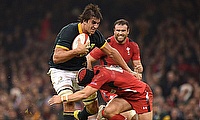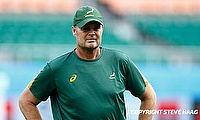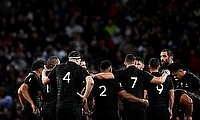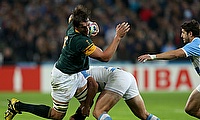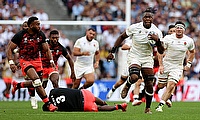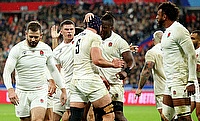Springboks lay their demons to rest
Following South Africa’s historic loss to Japan in their Rugby World Cup opener, Heyneke Meyer and his charges endured one of the worst weeks of their careers these past seven days, as the Springboks were left reeling by the Cherry Blossoms.
On Saturday, South Africa faced the unenviable task of bouncing back to form against a Samoa side with goals of topping Pool B, and who were riding high following their opening game win over the USA.
Six tries later and South Africa had recorded a much-needed 46-6 victory over the Islanders and in the process, put right many of the errors which had plagued them a week previously.
So, what exactly did the Springboks do against Samoa that they didn’t against Japan? We took a look under the hood and analysed South Africa’s impressive performance.
Defensive intensity and organisation
You didn’t need to have knowledge of their loss to Japan to see that the South African team was hurting. From the off, the line speed and attitude of the defensive line was one of controlled anger.
The wingers, JP Pietersen and Bryan Habana, as well as Jean de Villiers, were regularly up quickly, preventing Samoa from distributing the ball safely to their dangerous wingers. Ken Pisi and Alesana Tuilagi, Samoa’s wings, were limited to just 13 combined carries and neither player could surpass 23 metres with ball in hand. What those numbers don’t show is that the majority of those carries and metres made came either from South African kicks or the wingers looking for work inside in the midfield.
This defensive intensity wasn’t limited to preventing Samoan tries, it also helped create South Africa’s first try of the game, Pietersen’s interception score.
Below you can see Pietersen in a position which is fairly aggressive for a defending winger. He is confronted by three Samoan backs and in this situation it would be easy for him to panic. If he shoots up too quickly, he creates a dogleg for Samoa to exploit, but if he backpedals, he can’t fix his man and Samoa will likely create an overlap.
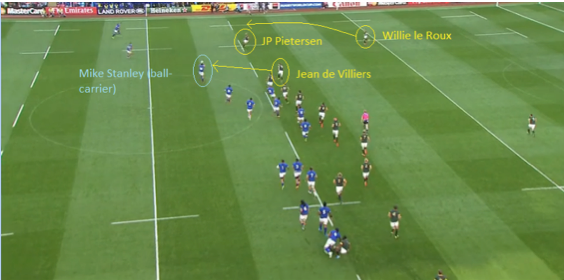
Instead, he trusts in the Boks’ defensive organisation. He knows de Villiers will come across and put pressure on the ball-carrier and he has faith that Willie le Roux can cover across and take the man on the outside channel, freeing him up to deal with the middle man.
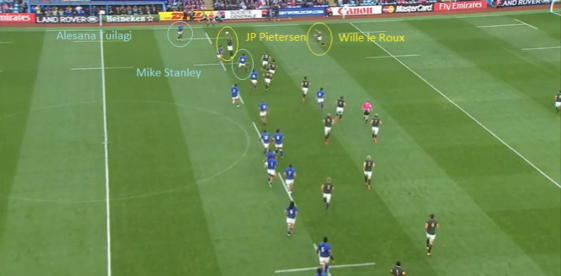
The speed of de Villiers puts pressure on Stanley and forces him into a quick decision. Stanley can either take contact from de Villiers, attempt a grubber kick or try the miss-pass to Alesana Tuilagi. With le Roux covering the area that Stanley can grubber into, his decision to throw a miss-pass is not a bad one, but he didn’t get the required elevation to beat the 6 ft 3 in winger and Pietersen is off to the races.
Maul and lineout success
Few nations pride themselves on the potency of their set-piece as much as South Africa do and Japan really humbled Meyer’s men in those areas, outsmarting the more powerful Springboks.
A Victor Matfield-inspired lineout and far more cohesive maul was able to redeem South Africa’s set-piece at Villa Park on Saturday, impressing right from the off. The first maul of the game actually came from a Samoan kick rather than a lineout, but it certainly set the tone for the rest of the game.
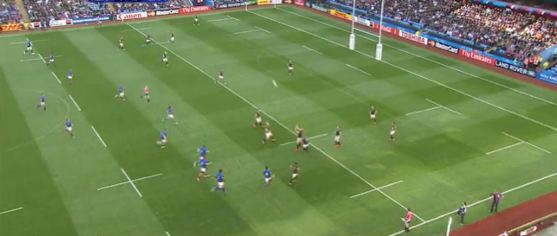
Teams are often at their most vulnerable right after scoring, but despite South Africa having just notched three points, their forwards were composed and concentrating. They collect the ball at the 22m line and immediately set up a maul.
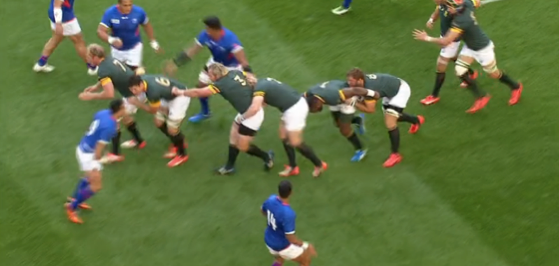
You can question whether or not this should be legal, but under the current laws, this form of ‘truck and trailer’ mauling is perfectly acceptable. South Africa did a great job of exploiting Samoa’s hesitancy to engage the maul and quickly began marching up the pitch.
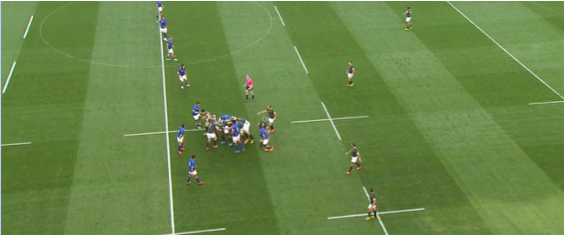
The Springboks marched the maul all the way up the 50m line where Samoa finally caved, dragging down the maul before it could gain any more ground and gave up a penalty which ensured South Africa would have a good attacking position from the resulting lineout.
It was a constant and effective attacking platform for South Africa and, with 10 minutes left to play, was used with skill to ensure the bonus point win.
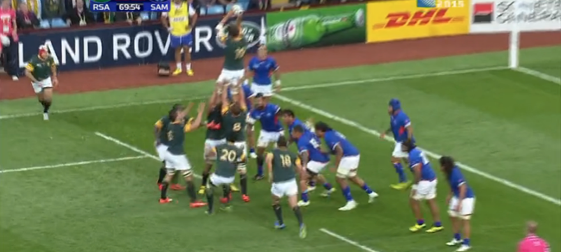
Samoa set up to counter the maul and not compete for the lineout on their own 5m line, but as soon as Lood de Jager claimed the ball, it was all over for Samoa.
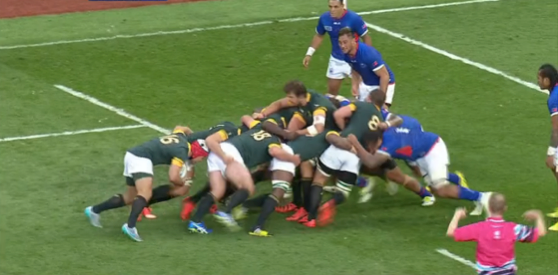
The Springboks had a numerical advantage, with Samoa unwilling to sacrifice blindside or openside fringe defenders, and combined with their low body heights, allowed them to push Samoa back and Schalk Brits to simply drop down over the try line. It was the exact move which Japan had used against them a week previously.
Before we move on to the next aspect of South Africa’s play, we should acknowledge the defensive lineout work of Matfield and Eben Etzebeth, both of whom wrought havoc on the Samoan set-piece. Of Samoa’s 10 lineouts, they lost six, with the Springboks astonishingly stealing four of those when the front pod was targeted. As you can see below, the hooker has thrown the ball and the South African jumper, in this case Etzebeth, is simply set and up long before the Samoan jumper has even left the ground.
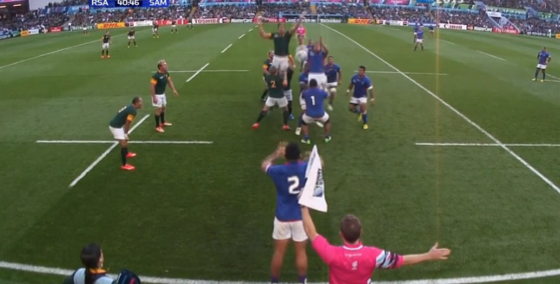
Midfield balance
The selection of Damian de Allende and de Villiers in the centres was one of the most talked about topics in the build-up to the Samoa game, but alongside Handré Pollard at fly-half, the midfield shone.
The balance hadn’t seemed right against Japan, with de Villiers and Kriel failing to complement each other in the way the two Stormers did on Saturday afternoon. The elusive footwork of de Allende at 12 was difficult for Samoa to contain, while de Villiers proved to be a contrasting threat at 13, running from deep at the inside shoulders of Samoan defenders.
The proclivity of de Allende to beat the first tackler, even from a standing start, meant that he was able to draw men to him all game long and create space for other players a phase or two down the line. At no time was this more apparent than in the build-up to Pietersen’s second try.
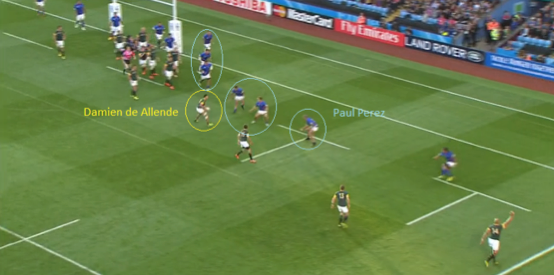
With Pollard having just carried the ball into contact, de Allende steps in at first receiver. He has been beating the first would-be tackler all game long and with the try line just five metres away, Samoa cannot afford to risk him doing the same again. The three defenders coming across from the ruck, the two defenders de Allende has squared up and even Paul Perez, who should be moving across to cover de Villiers, all have their eyes locked on de Allende.
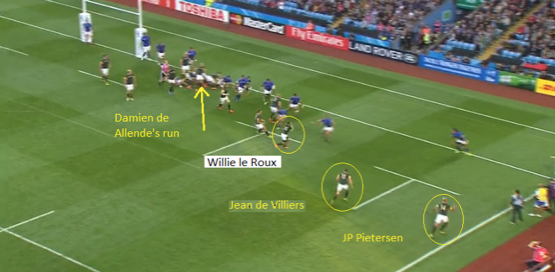
As a result, de Allende cuts back against the grain, taking five of those six defenders with him (Perez doesn’t bite, stays out with Tuilagi) and creates the space outside. South Africa quickly recycle, le Roux shows a fantastic pair of hands to receive and distribute the ball whilst fixing Perez, and de Villiers and Pietersen are able to comfortably finish a two-on-one against Tuilagi.
While we are talking about the South African midfield, it would be remiss not to mention Pollard, who certainly brought plenty of positives to the Springbok game plan. He kept the Samoan defence honest by mixing up his game, as he ran, distributed and kicked with good effect.
The pain of the loss to Japan won’t fade because of one good game, nor should it, but the Springboks were able to show on Saturday why they are still very much a threat to win this year’s RWC.
They still have plenty of areas to work on, not least so what to do in the midfield now that de Villiers’ RWC has been cruelly cut short with a fractured jaw, but also a scrum which has struggled to exert its authority in the two games so far.
All that said, the Boks now sit in a much prettier position in Pool B and head into this weekend’s clash with Scotland knowing that if they win, they are all but certain to finish top of pool and meet the runners-up of Pool A in the quarter-finals.











